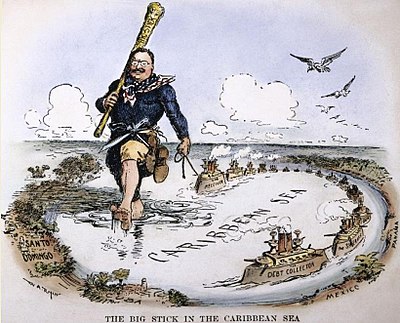The foreign policy of the Theodore Roosevelt administration covers American foreign policy from 1901 to 1909, with attention to the main diplomatic and military issues, as well as topics such as immigration restriction and trade policy. For the administration as a whole see Presidency of Theodore Roosevelt. In foreign policy, he focused on Central America where he began construction of the Panama Canal. He modernized the U.S. Army and expanded the Navy. He sent the Great White Fleet on a world tour to project American naval power. Roosevelt was determined to continue the expansion of U.S. influence begun under President William McKinley (1897–1901). Roosevelt presided over a rapprochement with the Great Britain. He promulgated the Roosevelt Corollary, which held that the United States would intervene in the finances of unstable Caribbean and Central American countries in order to forestall direct European intervention. Partly as a result of the Roosevelt Corollary, the United States would engage in a series of interventions in Latin America, known as the Banana Wars. After Colombia rejected a treaty granting the U.S. a lease across the isthmus of Panama, Roosevelt supported the secession of Panama. He subsequently signed a treaty with Panama which established the Panama Canal Zone. The Panama Canal was completed in 1914, greatly reducing transport time between the Atlantic Ocean and the Pacific Ocean. Roosevelt's well-publicized actions were widely applauded.
The Open Door Policy was the priority of Secretary of State John Hay towards China, as he sought to keep open trade and equal trade opportunities in China for all countries. In practice, Britain agreed but the Empire of Japan and the Russian Empire kept their zones closed. China had five times the population of the U.S., but outside the few treaty ports (controlled by Europeans), there was vast poverty. American schemes to build railways went nowhere; the one American product which the Chinese did buy was kerosene from Standard Oil for their lamps.[1][2]
Roosevelt admired Japan but American public opinion grew increasingly hostile. Roosevelt made clear to Tokyo that Washington respected Japan's control of Korea. He reached the Gentlemen's Agreement of 1907, effectively ending Japanese immigration in the hope of cooling bad feelings.[3]
Roosevelt sought to mediate and arbitrate other disputes, and in 1906 he helped resolve the First Moroccan Crisis by attending the Algeciras Conference. His vigorous and successful efforts to broker the end of the Russo-Japanese War, won him the 1906 Nobel Peace Prize.

- ^ Ernest R. May and James C. Thomson, eds, American-East Asian Relations: A Survey (1972) pp 131–172.
- ^ Michael H. Hunt. "Americans in the China Market: Economic Opportunities and Economic Nationalism, 1890s-1931." Business History Review 51.3 (1977): 277-307.
- ^ Charles E. Neu, An Uncertain Friendship: Theodore Roosevelt and Japan, 1906–1909 (1967) pp. 310–319.
© MMXXIII Rich X Search. We shall prevail. All rights reserved. Rich X Search
